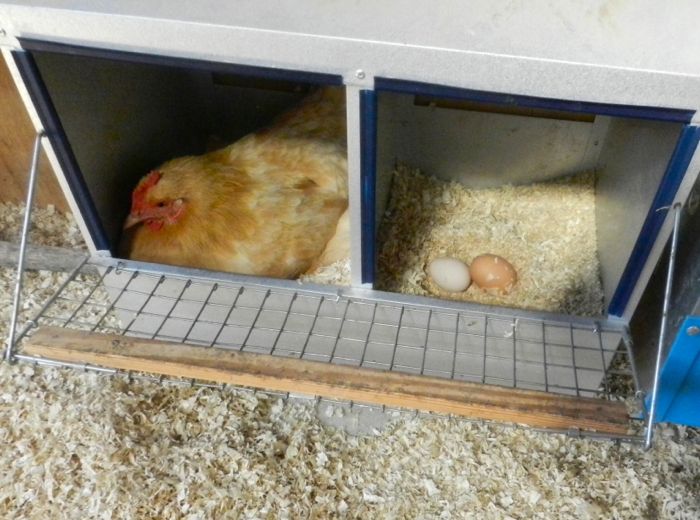As much as I like chickens, I don’t think I’d keep them if I didn’t get eggs. Collecting eggs is part of the experience. Cooking with the eggs, giving a carton as a gift and selling a dozen now and then, is inextricably linked to the experience of caring for and interacting with these animals. These are, after all domestic farm animals, with a purpose. That’s not to say to say that I expect the hens to be laying machines, and that each chicken has to lay an egg each day to earn her keep. That’s totally unrealistic. And you already know that I have a soft spot for the old, retired girls. Still, eggs are an essential part of the picture, and as such most people who go into backyard chicken keeping want to know how many chickens they should get in order to have enough eggs.
I can’t tell you how many hens you need in order to have eggs to supply your table. First of all, the more eggs you have, the more you eat! You might think that two eggs a day is plenty, and then you start eating eggs everyday for breakfast. Secondly, how many eggs your hens make depends on many factors, including their breeds, time of year, and their age. Still, let’s run through the numbers.
My pen of Gems is typical of a backyard flock. There are a variety of breeds. Some are known for their egg laying ability, like the Rhode Island Reds, and others go broody (those Orpingtons!) or are mostly decorative, like Pearl, the Cochin. They are now one year old, and so in the prime of their laying lives.
Summer, with it’s long sunny days and warm temperatures, is the peak laying season. In this almost-over month of July my twelve young hens have provided me with 225 eggs. That’s about 7 or 8 a day. That’s 18 cartons of eggs.
By August some chickens will begin to molt, and by September they’ll all be shedding feathers and taking a break from laying. I’ll find a few eggs in the nesting boxes, but not many. There might be a stretch of a few weeks when I find no eggs at all in the barn. By February they’ll start laying again, but in their second year they’ll produce about 20% fewer than the year before. And so it goes. By the fourth year several hens will have died and the remaining hens will be laying sporadically.
But for now, there is a surplus of eggs in the refrigerator.

Friends and neighbors give me used, clean cartons, which I use to store the eggs. I appreciate that, as new egg cartons can cost anywhere from 40¢ to 60¢ each. My eggs go into the refrigerator clean (for more about egg handling and storing see this FAQ) but if the cartons get even a tad dirty or worn, they go into the recycling bin. I write the date the eggs are collected on each carton. If I don’t do this, I lose track. I set aside a dozen to hard-cook later, and I make sure that the eggs that I sell are the freshest.
Today I’m visiting a friend. I’m bringing her a half-dozen. I package the eggs in new, clear plastic cartons both when I give eggs as gifts, and when I sell them. I carefully select a variety of shapes and colors. I make sure they’re clean and perfect. (I keep and use the eggs with imperfections.) This is what the carton looks like when it leaves my house.
Even after all of these years, I still get a small thrill when I share the bounty from my flock with others. So, back to the question of “how many hens do I need?” My own answer is that I want to have eggs for my table and some to share with others. At the same time, I’m not keeping chickens just for the eggs. If I did, then I’d have all look-alike hybrids, and cull them at 18 months. I like having a flock that is small enough so that I know each hen, and in which there is a variety of plumage and egg color and personality. I want the flock big enough so that there’s always a dozen eggs in the refrigerator with a few extra to be generous with. I’ve found that a laying flock of around eight to a dozen hens gives me this balance. I’m lucky that I have the space to keep my elderly chooks. By the time the old hens are gone, the Gems will be retired and I’ll get chicks again. Production waxes and wanes. It makes me appreciate those cartons in the fridge when I have them.



Beautiful nesting boxes. Do they have an opening in the back? Where can I get them?
My hens love these nesting boxes. I like that they’re easy to clean and being metal, don’t harbor mites. They’re made by a talented farmer in Georgia, so in buying them you support a family farm. They sell them at this Etsy.com shop. Tell them I sent you!
Don’t you love July! I’ve been waiting all year (planing, planting, watering and weeding) for fresh vegies from my garden. And now I’ve got so much corn, okra, beans, eggplant, and squash, more than I can eat! Yes, I freeze and can but it’s never the same as this fresh picked perfection of July! I’m glad my 3 ‘babies’ haven’t started laying yet! There is no room in the fridge.
Your garden is more abundant than mine, but I do get that same happy response to mine. Do you really use the okra?
I love okra but the rest of my family is luke warm. It is the ‘IT’ vegie right now and I’m finding lots of new recipies on the internet!
Terry, how long do you keep eggs for? How do you deal with gluts? I’ve got a glut at the moment and altho I sell some and give some away when I can and eat as many as possible, I still can’t keep up. I realise I’m lucky to have this “problem” but it is still a concern to see the boxes stacking up as I don’t want to waste the Girls’ hard work! And thanks for the tip re metal nest boxes not attracting mites – but don’t they get ever so hot? Sorry about so many questions xx
Karen, read my FAQ about egg storage and handling. As far as gluts – I do like pudding! When designing and siting your chicken coop, if you can, have one wall in shade, and put the nesting boxes on that side. That’s what I’ve done. The metal doesn’t get baked in sun.
Thanks so much Terry. Have read the FAQ – should have done that before, ahem – I had no idea you could freeze eggs so am chuffed. I will label them carefully: salted ones (for winter breakfasts of scrambled eggs) and sugared ones (for winter bake-ins). Thank again.
Tried to find the post on how to freeze eggs? Can you direct me to it?
It’s in the “handling and storing eggs” FAQ.
I’m getting 6 to 8 eggs per day, ranging between peewee to what I am calling Super Jumbo size (3.15 ounces) from my 8 hens. I just made a vanilla pudding pie in a Keebler Shortbread Crumb crust. Yum. Thanks for the pudding recipe Terry!
So happy that you made the pudding!
I’m not having such a good summer for eggs … 10 hens and averaging 4 eggs a day. We’ve had such a variable (and wet) summer here in the UK I’m trusting that it’s just the weather!
The girls are sensitive to weather. A lot of people in the states, where it’s been brutally hot, have also seen their egg count go down.
I too have found eight to be a nice number. I like your plastic cartons, where do you purchase them? In the fridge I use plastic four lock cartons, with the oldest eggs in the carton on top and new eggs go into the carton below. Thanks for all the info that you share.
Eggcartons.com has a good selection of cartons, and they’re a local company (same state) so I use them. I bought one huge box of cartons a couple of years ago, and am still using them up.
Eggs from hens can pile up quickly. Glad to know you have several ways of handling them. And the Buff Orphingtons are at it again. When Buffy became broody when she was younger, was as mean and crazy a broody as her fellow Buffs, or was she a calm one like Pearl ?
Buffy was the classic huffy broody hen. But I do need to clarify – I never think they’re mean. I don’t get defensive pecking. They chrrrr in their bad moods, but I can always handle them.
good morning terry, i just wanted to let you know i made your NoKnead Bread yeasterday. i’ve not made bread before. the recipe was easy and the bread was fabulous.just the way we love it.crusty crust and moist and chewy inside. we had it with a vegetable soup w/vegies from our yard.it was so special. later in the evening when my son noticed the bread was gone(thanks to my husband)he asked me to make another loaf.so as i am writing,another loaf is rising!! thank you so much.
Excellent! That break can be tricky the first time. You should be very proud of yourself!
Funny you should post this Terry….I LOVE my birds but had an “AH HA” moment…Once again we were trying to get away for an anniversary..and who will feed the 52 birds, 4 horses, llama, and assorted cats? I told my husband I am going to keep a flock of 20….when my girls pass..I will not replace them, only when my hens supply dwindles. The feed prices here in California are horrible..how about there? That is the other bad side of having a large backyard flock…..
Feed prices continue to go up and I expect a spike because of this year’s drought in corn country. 50 pounds of laying hen pellets costs $17 to $18 a bag. My 12 Gems go through a bag every 2 weeks or so.
I have laying hens about 18 months old last summer at this time I was getting 4 to 6 eggs a day, this summer i have only been getting 1 to 3, they are healthy i think its just been to hot and i have gotten new chicks and moved them to a new house so all of this could be playing a factor…
Heat and stress can certainly reduce the number of eggs. And now we’re hitting the beginning of molting season (the poorest layers start molting now, the best layers more towards September.) I’ve already stated seeing feathers on the floor of the Gem’s coop.
We have our first egg this morning…so excited! I have heard that the first few are small. Do they gradually get bigger and are these first small good to eat?
Thanks
Congratulations! Yes, they’re perfectly good for eating. Sometimes the first egg is a “wind egg” and will be teeny-tiny and yolkless. (I save them and let the dry out. Too cute to use.) The first eggs will be smaller, then gradually increase in size. All edible. Enjoy!